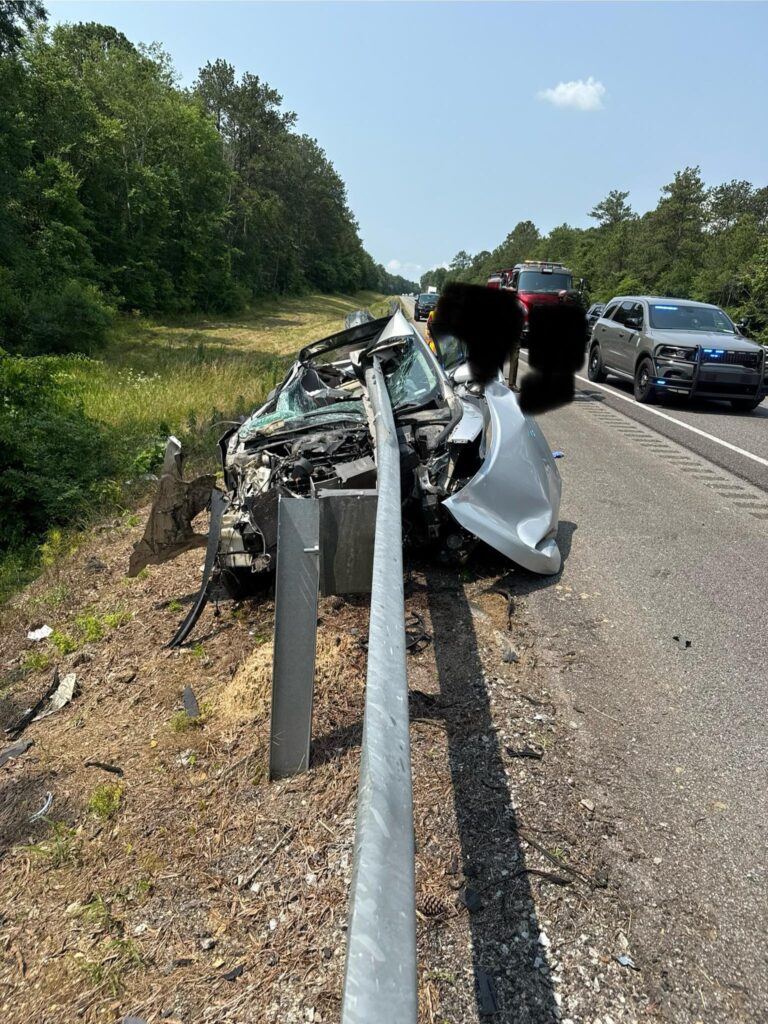Driver Survives I-59 Crash in Steele; Fire Officials Urge Caution Over Drowsy Driving

STEELE, AL – A driver is fortunate to be alive after a violent crash along Interstate 59 in Steele on Monday, when they reportedly fell asleep at the wheel and collided with a guard rail. The vehicle suffered severe damage and was described as nearly unrecognizable, yet miraculously, the driver walked away uninjured, according to the Steele Fire Department.
“On duty personnel and our wonderful VOLUNTEERS responded to a motor vehicle accident on I-59. The vehicle was occupied by a driver who fell asleep at the wheel. He was unharmed. We would like to remind everyone if you are tired pull over and rest. Don’t risk your life and the lives of others.”
Officials are using the incident to renew warnings about the dangers of drowsy driving—a persistent and often underestimated hazard on America’s roads.
A National Safety Threat
Drowsy driving is responsible for thousands of crashes every year. According to the National Highway Traffic Safety Administration (NHTSA), an estimated 91,000 vehicle crashes and nearly 800 deaths in 2017 were directly linked to fatigued drivers. The actual numbers may be significantly higher due to underreporting.
Sleep deprivation can impair attention, coordination, and reaction time—effects comparable to those of alcohol intoxication. Going 24 hours without sleep can create impairment similar to a blood-alcohol level of 0.10%, above the legal driving limit in all U.S. states.
Certain groups are more at risk, including:
-
Commercial vehicle drivers
-
Shift workers
-
Individuals with untreated sleep disorders
-
People taking medications that cause drowsiness
Most drowsy driving crashes occur on rural roads and highways, particularly between midnight and 6 a.m. or during the late afternoon, when the body’s natural circadian rhythms dip.
Signs and Risks of Drowsy Driving
According to the American Academy of Sleep Medicine, drivers should watch for the following warning signs:
-
Frequent yawning or blinking
-
Difficulty keeping eyes open or head upright
-
Trouble remembering the last few miles driven
-
Missing road signs or exits
-
Drifting out of lanes or hitting rumble strips
Of particular concern are “micro sleeps”, which are involuntary episodes of sleep that last four to five seconds. At highway speeds, this can mean driving the length of a football field without being conscious.
What To Do If You Feel Drowsy While Driving
If you begin experiencing any of the above symptoms, pull over immediately to a safe, well-lit area. Experts recommend a short nap—about 20 minutes—combined with a caffeinated beverage for temporary alertness.
However, caffeine alone is not a substitute for adequate rest. The effects wear off quickly, and drowsiness can return suddenly.
Prevention Tips for Drivers
To help reduce the risk of falling asleep at the wheel, experts recommend the following preventive steps:
1. Get Enough Sleep
Adults need at least 7 hours of sleep per night. Teens need 8–10 hours. Chronic sleep deprivation significantly increases the risk of driving while drowsy.
2. Avoid Alcohol and Certain Medications
Even small amounts of alcohol can cause fatigue. Some over-the-counter and prescription medications also list drowsiness as a side effect. Always check the label before driving.
3. Plan Around Peak Drowsy Hours
Try to avoid driving during known danger periods, particularly late at night and early afternoon. If driving during these hours is unavoidable, stay vigilant.
4. Practice Good Sleep Hygiene
Establish consistent bedtimes, limit caffeine and electronics before bed, and create a restful sleep environment. Experts suggest a bedroom temperature of around 65°F for optimal rest.
5. Seek Medical Advice if Needed
Persistent fatigue or poor sleep may be a sign of an underlying condition such as sleep apnea or insomnia. Consult your physician if symptoms persist.
Bottom Line:
Monday’s near-tragic crash in Steele serves as a stark reminder: drowsy driving can be just as dangerous as drunk driving. Staying alert behind the wheel starts with healthy sleep habits—and knowing when it’s time to take a break.





